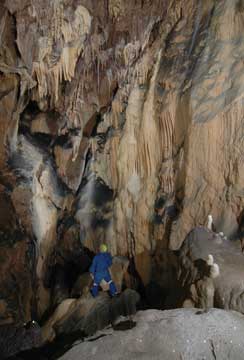|
News Notes
Geology
Cave discovery dazzles national park
 Upon first
inspection, the hole in the ground at Sequoia and Kings
Canyon National Park in California appeared small, about the size
of a baseball. As Scott McBride and fellow explorers with the Cave
Research Foundation started pulling away dirt and rocks, however,
the opening grew wider and deeper, eventually revealing one of the most
spectacular caves yet discovered at the park. The find could help scientists
learn about the geologic history of the Sierra Nevada.
Upon first
inspection, the hole in the ground at Sequoia and Kings
Canyon National Park in California appeared small, about the size
of a baseball. As Scott McBride and fellow explorers with the Cave
Research Foundation started pulling away dirt and rocks, however,
the opening grew wider and deeper, eventually revealing one of the most
spectacular caves yet discovered at the park. The find could help scientists
learn about the geologic history of the Sierra Nevada.
Cave explorer Alan Hager examines features in the first large room of a newly discovered cave in California’s Sequoia and Kings Canyon National Park. Future work in the cave might help researchers better understand the geologic history of the Sierra Nevada. Photograph is by Dave Bunnell.
Since the initial Aug. 19 find, explorers have bravely rappelled 25 meters down into the cave to begin exploring and mapping its features, says Alexandra Picavet, a spokesperson for the park. Investigation thus far has turned up three large “well-decorated” rooms — some spanning more than 15 meters across, she says.
Hanging from the ceilings are rows of nearly 2-meter-long soda straws — thin, hollow tubes that form as water drips from their end, leaving behind miniscule rings of calcium. Flowing water left behind mineral deposits, which over time grew into colorful “curtain” and “flowstone” features, some of which are adorned with sheets of sparkling crystals. At the floor of one room, researchers discovered a lake that might be 30 meters wide.
The cave, named Ursa Minor by its discoverers after they found bear remains there, is only one of 240 caves at Sequoia and Kings Canyon National Park, and new caves are found every year. “We have several caves that have really large rooms, and we have several caves that are really well-decorated,” Picavet says. “This cave seems to take all of those elements and put them into one.”
Indeed, the cave has “an unusual geology,” says Joel Despain, a cave specialist for the park. While Ursa Minor was influenced by flowing water, like most of the caves in the park, “the reason for the cave’s large rooms and for steep infeeding passages at the extreme downstream end of the cave remains unclear,” he says.
Additional exploration is needed to determine the full extent of the cave, and what new species might be living in the environment. Also, additional research could provide information about the history of uplift and downward erosion of the Sierra Nevada, “which is in contention among geologists,” Despain says. The cave’s multiple levels define the height of past stream levels relative to the Sierra Nevada, so dating various levels of the cave could provide researchers with a detailed history of stream incision, he says.
Further exploration, however, may be on hold for a few years, until the national parks can budget the money needed to launch studies to appropriately map and document the cave, Picavet says. “Obviously, it didn’t come with a pot of gold at the bottom of it.”
Kathryn Hansen
Links:
Sequoia
and Kings Canyon National Park
Cave
Research Foundation

 Subscribe
Subscribe

